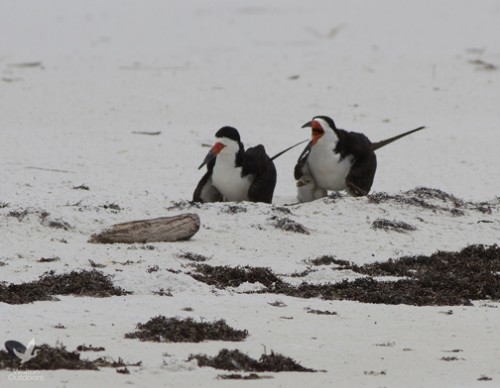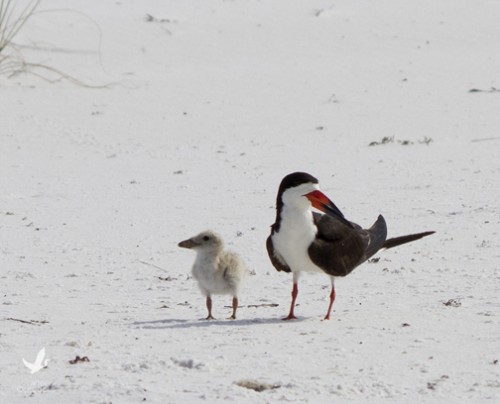
Learn about the shorebirds and see the chicks up close through a birdscope this Sat. and Sun.
A pair of black skimmers have successfully nested and hatched three chicks at Henderson Beach State Park this summer. These beautiful shorebirds arrived at Henderson right after July 4, 2014. Approximately 4-5 days later, three eggs were laid three days in a row.
Black skimmers are not often seen in the Okaloosa/Walton area, and this species typically nests within a colony of other skimmers.

Mates take turns scraping the sand to create a nest, kicking sand behind them with alternating foot strokes. They then rotate in their scrape to create a saucer-shaped depression. The average scrape is 10 inches in diameter and 1 inch deep.
It’s been a precarious journey for the little ones as the eggs were hatched in a congested area along the beach and close to the shoreline. A large area was roped off for their safety according to park services specialist Lynda Smith.
As of Aug. 22, so far so good according to Smith. The three chicks are doing well and may be ready to fledge in another two weeks.
If you are interested in seeing these beautiful shorebirds and their chicks, head over to Henderson and take a peek. There will be an Audubon shorebird steward with a scope for better viewing on Saturday and Sunday from 11 a.m. – 5 p.m.
Click here to learn more about Henderson Beach State Park.
Cool facts about black skimmers:
- The Black Skimmer is the only American representative of the skimmer family. The other two, rather similar, species are the African Skimmer and the Indian Skimmer. All use the same unusual feeding method.
- Although the Black Skimmer is active throughout the day, it is largely crepuscular (active in the dawn and dusk) and even nocturnal. Its use of touch to catch fish lets it be successful in low light or darkness.
- At hatching, the two mandibles of a young Black Skimmer are equal in length, but by fledging at four weeks, the lower mandible is already nearly 1 cm longer than the upper.
- Possibly the best description of the Black Skimmer’s bounding, head-down foraging style came from R. C. Murphy in 1936. He said they look like “unworldly… aerial beagles hot on the scent of aerial rabbits.”
Cool facts information courtesy allaboutbirds.com
